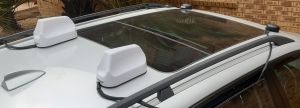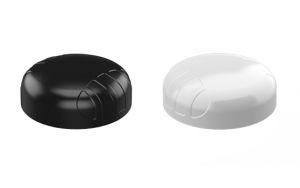
Poynting PUCK vs MIMO-3 Test Drive
Background
All cellular (wireless) routers have transmission blocks for wireless communication which are based on industry and telecom standards. It is therefore crucial to choose the right antenna for your application. Never underestimate the role of the antenna as it will directly influence customer satisfaction and your bottom line.
It is important to understand some principles of antenna design when considering an antenna.
- A bigger antenna will be able to serve more frequencies and provide higher gain.
- A multi-frequency antenna will not perform equally well at each frequency.
- Antenna radiation patterns should have the maximum gain directed to where base stations can be expected.
- Gain is an important parameter but should be evaluated based on the type of antenna. In the case of a directional antenna a higher gain is normally better. In case of an Omni-directional antenna, the challenge is to evenly spread the gain in each direction, in such a manner that the gain varies little over the frequency band.
The Route

Poynting’s partner WiLink, based in Warsaw Poland, did a test of the Poynting PUCK-5 and MIMO-3-V2-15 antennas and the Peplink HD-4 cellular modem. Two MIMO-3-V2-15 and two 2 PUCK-5 antennas were mounted on a vehicle which drove from Warsaw to Karpacz in the south of Poland. During this trip the router in the vehicle were continuously streaming HD video to the control and monitoring centre at the customer site.
The goal of this trip was to judge which antenna would best fit the projects’ requirements. It was also a good opportunity to see (in practice) what the difference in performance are between the much bigger MIMO-3-V2-15 vs the smaller PUCK-5 antenna.The trip was approximately 500 kms long, driving in and around Warsaw, Lódż Wrocław, Jelenia Góra and Karpacz, in the south of Poland.
The Router and Antennas
The system was set up as follows:
A Peplink MAX HD4 LTE-A Quad 4G LTE Mobile Router with 4 modems were used. Poynting used SIM cards from one network provider (PLUS) in two of the modems. Poynting then connected two different antennas (PUCK-5 vs MIMO-3-V2-15) to these modems. Poynting inserted SIM Cards from different network providers (Orange and T-Mobile) in the other two modems and connected a PUCK-5 or MIMO-3-V2-15 to each.
To summarise the modems were linked to the following antennas and network providers or carriers:
- Modem 1 Poynting MIMO-3-V2-15 carrier: PLUS
- Modem 2 Poynting PUCK-5 carrier: Orange
- Modem 3 Poynting MIMO-3-V2-15 carrier: T-Mobile
- Modem 4 Poynting Puck-5 carrier: PLUS

More about the antennas used during this trip:
The PUCK-5 is a robust multifunctional 5-in-1 ultra-wide band omni-directional antenna with 2 m RKT-031 cable and a variety of mounting options. In the antenna enclosure you will find:
- Two LTE Antennas that covers the 698 – 3800 MHz bands
- One Dual Band Wi-Fi Antenna
- One GPS/Glonass Antenna

Size: Ø99.3 mm Height: 36mm
The MIMO-3-V-2-15 is a high performance, robust multifunctional 5-in-1 Antenna that comes with 2m fire-retardant high-quality cable and a variety of mounting options. In the antenna enclosure you will find:
- Two LTE Antennas that covers the 450-3800 MHz bands
- Two 2.4 & 5 GHz Wi-Fi Antennas
- One GPS/Glonass Antennas

Size: 253mm x128mm Height: 144mm
Some important information and benefits of the Poynting antennas:
- Frequency range:
- PUCK-5: 698 MHz – 3800 MHz. The antenna is truly omni-directional at all the main cellular frequencies used in Europe.
- MIMO-3-V2-15: 410 MHz – 3800 MHz. The antenna is also truly omni-directional at all the main cellular frequencies used in Europe as well as the 450 MHz which is used widely in Norway.
- Future proof! Poynting is one of the first to introduce the new 5G frequencies in its antenna solutions.
- True omni-directionality. The radiation patterns at all usable frequencies ensures that the antenna radiates equally in each direction, 360 degrees around its axis. Poynting also ensures that the energy is radiated there where base stations may be expected (not into the sky or into the ground).
- The variation of the gain measured on each frequency is optimized across all bands and kept as low as possible. This is to secure optimal performance in each direction.
- All antennas in the housing is isolated, to reduce interference and negative influences.
The results
It was critical for the customer to have a constant, live video stream from the vehicle to the monitoring centre in Warsaw, at the best quality possible.
As one PUCK-5 and one MIMO-3-V2-15 were operating on the sim-cards of the same service provider, Poynting could compare their performance on the same network. The other antennas were mounted to the other 2 available modems and connect to two different operators. For the most part the vehicle was driving at speeds above 120km/h as 140 km/h speeds are allowed on the highways and 110 km/h on the “dual carriage ways”.
The conclusions
- The first conclusion is:
- This solution (Peplink HD4 + both Poynting antennas) allowed us to carry out the transmission almost without interruption during whole route.
- Combining active modem connections from different carriers ensured a constant connection throughout the entire route.
- Bonding active modem connections worked throughout the entire route sending packets with links that provided the best parameters.
- The second observation is:
- The PUCK antenna ensured connection on almost the entire route. In some remote areas the size of the antenna limits the range and short connectivity losses occurred. Even though the disconnects were truly short, the antenna is more suitable for urban and relatively good signal areas.
- The MIMO-3, which is a much bigger antenna, did not lose connectivity during the complete trip. It still stayed connected to network in the areas where the PUCK-5 antenna experienced difficulties. Size matters!
- The MIMO-3 performed better at the lower frequencies than the PUCK-5 antenna. In remote areas the lower frequencies are preferred by operators, hence the difference in performance.
The test drive clearly demonstrates the importance of the choice of the right antenna for your applications:
- There is a compromise between smaller and bigger antennas in terms of performance, connection reliability and costs of ownership.
- The Poynting PUCK-5 antenna is extremely well designed in terms of radiation patterns and designed to perform optimally at each frequency.
- The Poynting MIMO-3-V2-15 performed extremely well during the complete trip. It stayed connected to the network, except when adjustments were made to the router.
The download and upload speeds varied during the trip and the differences in the network coverage of the different operators were visible during the trip.
Poynting’s partner and their customer were extremely impressed by the performance of the antennas as well as the additional value that the Poynting antennas added to their systems. The antennas do have a great impact on the bottom line and overall customer satisfaction.
You cannot always pick the best antenna available as there are restrictions due to size, personal preference, budget etc. It is therefore important to understand the compromise you must make when choosing an alternative antenna.
To summarise the MIMO-3-V2 will keep you connected whether you are travelling in remote areas (through the mountains or at the seashore), but also in large cities and urban areas. Whether you are taking the high-ways or the country roads a Poynting “anywhere and everywhere” MIMO-3 antenna will keep you connected.
If the connectivity is less critical or you are traveling in areas with better signal, the PUCK-5 antenna will be a really good choice and will outperform most other available solutions in terms of connection reliability and overall performance for mobile and fixed installations.
Poynting antennas come in different size and form-factors and are always optimized for performance. Poynting – Making Wireless Happen!
